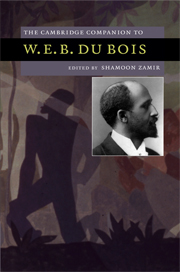Book contents
- Frontmatter
- Introduction
- 1 The Souls of Black Folk: Thought and Afterthought
- 2 “Of the Coming of John”
- 3 The Fiction of W. E. B. Du Bois
- 4 Du Bois and the “New Negro”
- 5 Du Bois, Black Leadership, and Civil Rights
- 6 Du Bois, Race, and Diversity
- 7 Du Bois on Race: Economic and Cultural Perspectives
- 8 Africa and Pan-Africanism in the Thought of Du Bois
- 9 The Place of W. E. B. Du Bois in American and European Intellectual History
- 10 Race, Marxism, and Colonial Experience: Du Bois and Fanon
- Further Reading
- Index
5 - Du Bois, Black Leadership, and Civil Rights
Published online by Cambridge University Press: 28 November 2008
- Frontmatter
- Introduction
- 1 The Souls of Black Folk: Thought and Afterthought
- 2 “Of the Coming of John”
- 3 The Fiction of W. E. B. Du Bois
- 4 Du Bois and the “New Negro”
- 5 Du Bois, Black Leadership, and Civil Rights
- 6 Du Bois, Race, and Diversity
- 7 Du Bois on Race: Economic and Cultural Perspectives
- 8 Africa and Pan-Africanism in the Thought of Du Bois
- 9 The Place of W. E. B. Du Bois in American and European Intellectual History
- 10 Race, Marxism, and Colonial Experience: Du Bois and Fanon
- Further Reading
- Index
Summary
Of foremost importance in defining the Civil Rights Movement in the United States is the question of periodization. When raised as a historical topic, often the term “civil rights movement” conjures images of events such as the Montgomery Bus Boycott and the 1963 March on Washington. Inextricably linked to those events are people such as Reverend Dr. Martin Luther King, Jr. and Rosa Parks. Issues of concern that they are known for advocating include voting rights and desegregation. And while these people, issues, and events all legitimately constitute the modern-day Civil Rights Movement, accurately situating the struggle for civil rights along a historical continuum is key. This is particularly the case when examining the role of W. E. B. Du Bois as both a central black leader in the drive for equal rights for blacks, as well as an architect of the later Civil Rights Movement.
This chapter explores two aspects of Du Bois's civil rights activism: his role in forming a concept of black leadership rooted in a “Talented Tenth” and his organizational activism. From 1905 to 1915 Du Bois grappled with the intellectual and strategic problem of the appropriate demands black Americans needed to make of a democratic nation still treating its minorities as second-class citizens. Integration or “separate but equal” accommodation and education? What was best for the future of black Americans: education in vocations, such as blacksmithing and teaching, or a liberal arts education? Who would lead this rising black nation?
During the period from 1910 to 1935 Du Bois served as a founding member and only black board member for many years with the National Association for the Advancement of Colored People (NAACP). Du Bois was also the editor of the NAACP’s periodical Crisis, which, under his editorship, was a lightning rod for debating the pressing issues facing the NAACP’s constituency. His involvement with the NAACP and the Crisis marks what some believe to be the height of Du Bois’s pre-eminence as spokesman for black America.
- Type
- Chapter
- Information
- The Cambridge Companion to W. E. B. Du Bois , pp. 76 - 85Publisher: Cambridge University PressPrint publication year: 2008



